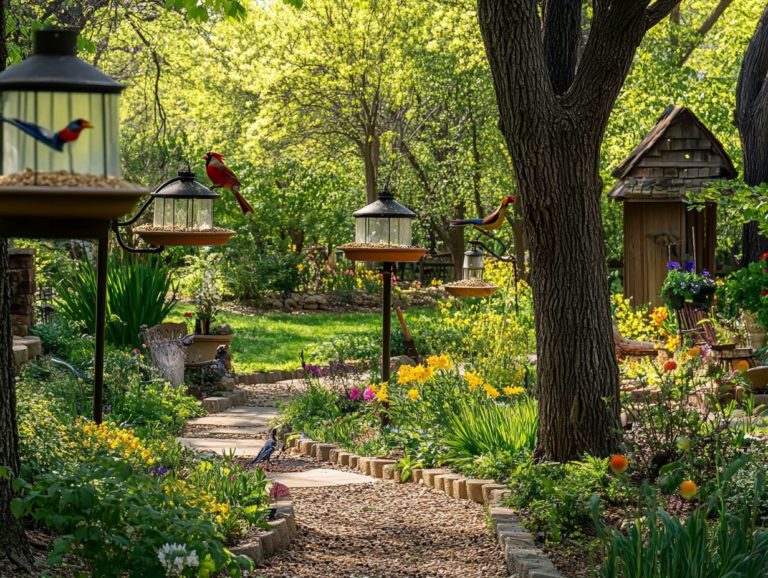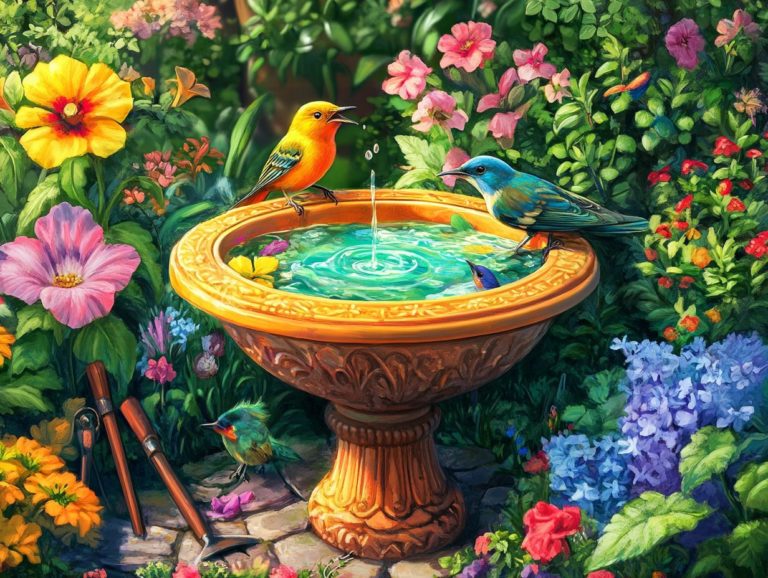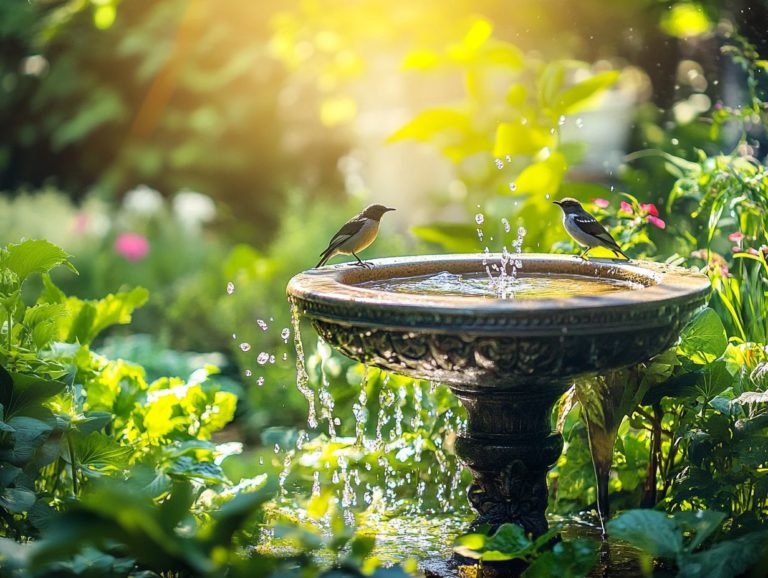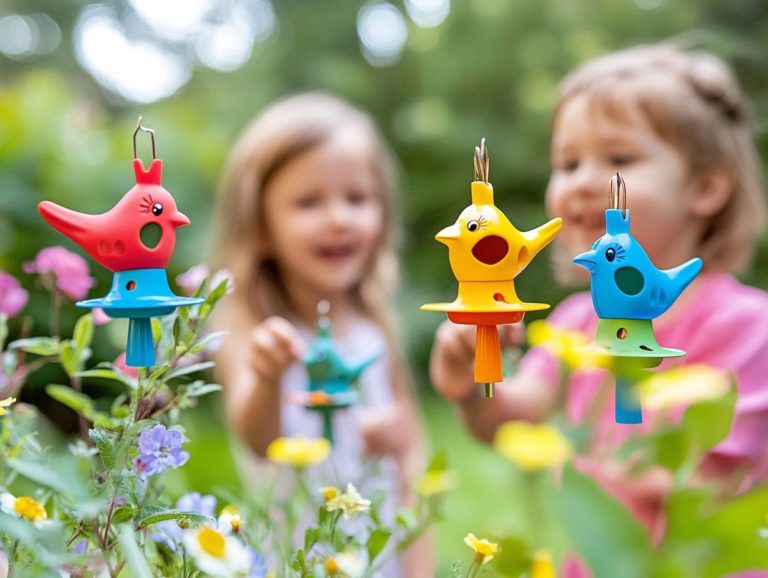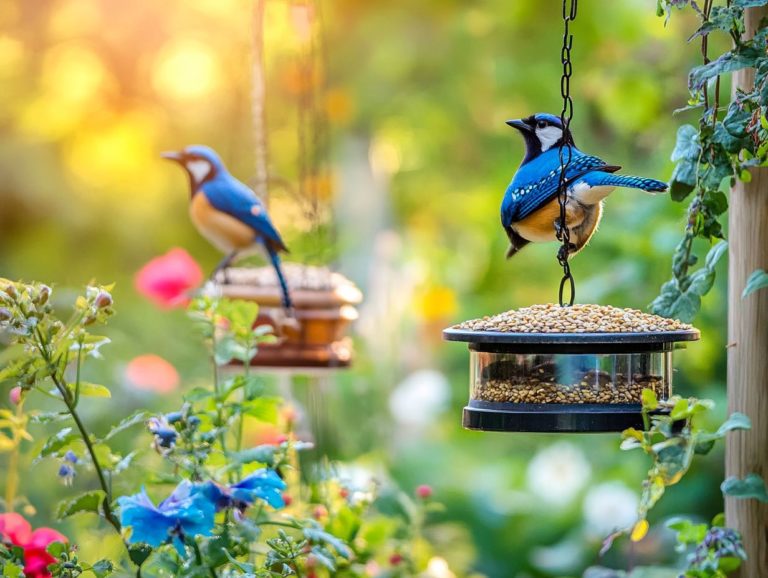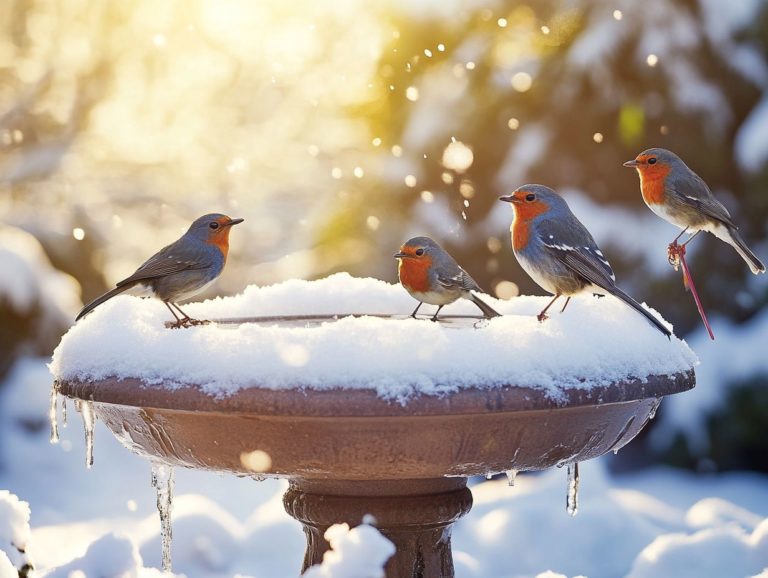How to Choose a Bird Feeder for Your Budget
Bird feeders can transform your garden into a vibrant sanctuary. They invite a delightful array of birds, bringing the beauty of nature right to your window.
With numerous options available platform, hopper, tube, suet, and window feeders it s crucial to select the perfect type that suits your space and your feathered visitors.
This guide explores various feeder options, important factors to consider based on your budget, and even shares some DIY ideas for crafting your own feeders.
Whether you re a seasoned birdwatcher or just starting, you ll discover valuable tips to elevate your bird-feeding experience.
Contents
- Key Takeaways:
- Understanding Different Types of Bird Feeders
- Factors to Consider When Choosing a Bird Feeder
- DIY Bird Feeders on a Budget
- Frequently Asked Questions
- 1. What should I consider when choosing a bird feeder for my budget?
- 2. How can I attract a variety of birds while staying within my budget?
- 3. Are there any cost-effective DIY options for bird feeders?
- 4. Is it worth investing in a more expensive bird feeder?
- 5. How often do I need to refill my bird feeder and how does it affect my budget?
- 6. Are there any low-maintenance bird feeder options for those on a budget?
Key Takeaways:
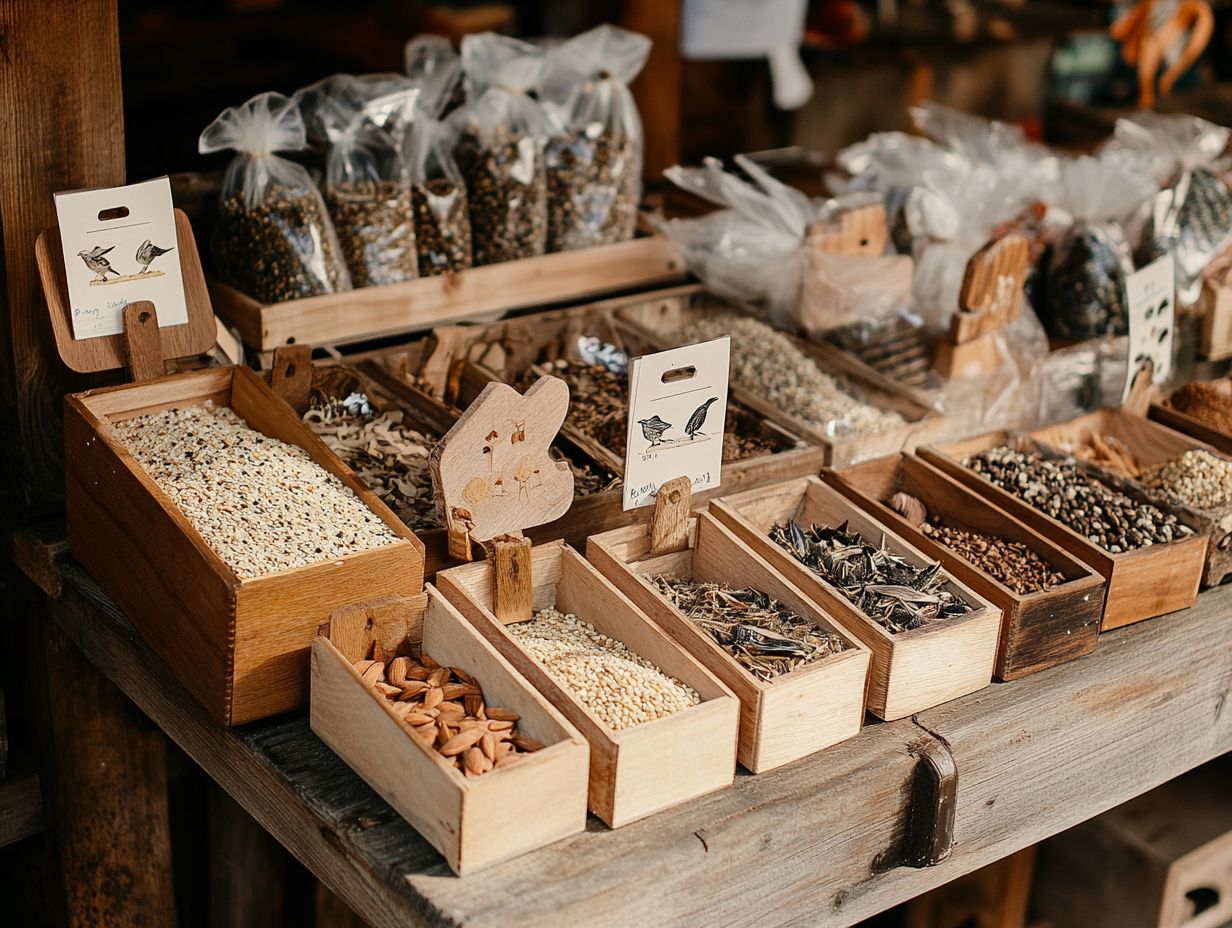
Choose a bird feeder that fits your budget by considering feeder type, material, bird species, location, and maintenance.
Different feeder types attract different birds. Research local species to find the best feeder for them.
Save money by making your own bird feeder with simple materials or repurposing items you already have at home.
Understanding Different Types of Bird Feeders
Understanding the different types of bird feeders is essential for anyone wanting to attract a variety of wild birds to their outdoor space. Knowing their feeding habits enhances your success.
Each feeder type seed feeders, tray feeders, hummingbird feeders, or suet feeders caters to the unique feeding habits of various bird species.
Selecting the right feeder enhances your bird-feeding experience while also supporting bird conservation efforts by providing appropriate food sources for local bird populations. Let s explore exciting options to attract beautiful birds!
Platform Feeders
Platform feeders are excellent for attracting a diverse array of bird species. They provide ample space for multiple birds to feed simultaneously.
These feeders hold a wide variety of seeds and snacks, drawing in species from finches to grosbeaks. The open design allows birds to perch comfortably, which is essential for those that prefer to eat while sitting.
Cleaning platform feeders is straightforward; many models have removable trays that can be washed easily. This keeps food fresh and minimizes the risk of disease.
To maximize effectiveness, place these feeders in shady, quiet areas with natural cover nearby. This provides birds with a sense of safety as they dine.
Regular maintenance, like clearing away old seeds and debris, keeps your feeding station inviting and hygienic.
Hopper Feeders
Hopper feeders are a great choice if you’re looking for a long-term investment that attracts various birds year-round, even in winter.
These feeders typically have a covered design that holds a generous supply of seeds while shielding food from rain and snow, making them winterproof.
Your bird guests will always find dry and accessible nourishment. Maintaining a consistent food supply is crucial in colder seasons when natural food sources dwindle.
By opting for this type of feeder, you can attract a variety of birds, from larger ones like cardinals and jays to smaller ones like finches and sparrows. This enhances your birdwatching experience.
The elevated platform and ample perches allow multiple birds to feast simultaneously, enriching your birdwatching adventure.
Start your bird-feeding adventure today!
Tube Feeders
Tube feeders are a top choice for bird enthusiasts like you who want to attract smaller birds, such as finches. These feeders specifically serve nyjer seeds, which are small seeds that many small birds love. This design allows these delightful birds to feed efficiently while keeping larger birds away, ensuring a better experience for backyard birds.
You ll find tube feeders in various designs with multiple feeding ports and adjustable feeding holes. These features help keep larger birds at bay while welcoming finches and other small species. They’re easy to clean and maintain. Their slender, vertical shape minimizes spillage and waste, making them an efficient option for your backyard birdwatching experience.
To truly enhance the experience for your cherished avian guests, consider placing the tube feeder in a sheltered spot. This provides protection from the elements while being visible to the birds, helping you identify them more easily. You can also incorporate baffles to deter pesky squirrels, ensuring that only your intended visitors enjoy the nutritious treats inside.
Suet Feeders
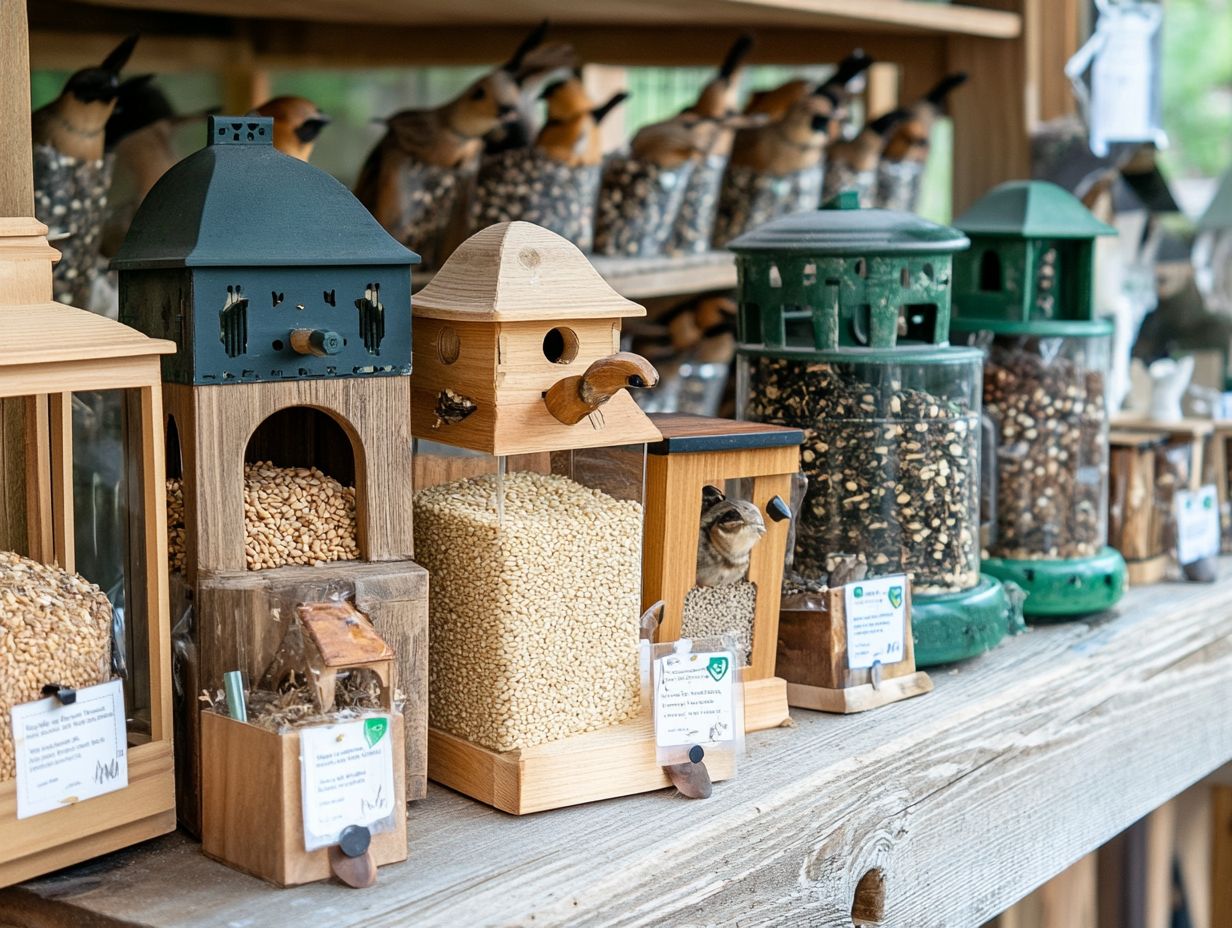
Suet feeders are critical for attracting insect-eating birds like woodpeckers, chickadees, and nuthatches, especially during the colder months when their natural food sources dwindle. Providing suet is particularly important for those who enjoy bird watching.
These feeders offer a rich source of fat that gives birds energy. This is crucial for sustaining birds as they search for food, especially when feeding garden visitors. By offering suet, you not only entice these delightful species but also invite a diverse array of avian visitors, especially during migration seasons when they seek extra nourishment to support their natural diets.
Maintaining the feeder regularly is vital. Ensure it remains clean and free from mold to promote bird safety. This practice keeps the feeding area accessible and fosters a safe environment for a variety of birds, enhancing their presence in your garden.
Window Feeders
Window feeders offer you a remarkable way to witness backyard visitors up close. This makes it effortless to identify various bird species as they feed right outside your window, enhancing your bird identification skills.
These feeders elevate your bird-watching experience and improve accessibility for those with mobility challenges. Everyone can enjoy nature without stepping outdoors, making bird feeding a hobby for all.
Installing a window feeder is a simple endeavor; most designs use robust suction cups to securely attach the feeder to the glass. This ensures it stays firmly in place and is easy to clean.
Select a location that provides an unobstructed view while prioritizing the safety of the birds. Position it away from potential predators to ensure a safe feeding environment.
With the right feeder, you can attract a delightful array of species, from vibrant finches to cheerful chickadees. Transform your window into a lively portal to the enchanting world of birds while observing their feeding behavior.
Factors to Consider When Choosing a Bird Feeder
Selecting the perfect bird feeder requires thoughtful consideration of several key factors:
- Your budget
- The materials used in its construction
- The particular bird species you wish to invite into your backyard, including common birds
These elements are essential for ensuring the feeder’s durability and the safety of its avian visitors while effectively attracting wild birds.
Being mindful of your feeding preferences and the maintenance tasks involved will elevate your bird feeding experience, making it both enjoyable and rewarding for you and the local bird populations.
Budget
Ready to transform your backyard into a bird haven? Let s dive into how to choose the best feeder!
Budgeting for a bird feeder is crucial to ensure you choose a high-quality option that serves as a long-term investment in attracting delightful backyard birds. To enhance your experience, consider understanding bird feeder preferences to maintain their health and happiness.
By thoughtfully examining your budget limits, you can weigh the pros and cons of the various feeder types available on the market, including options like how to make a DIY bird feeder, ensuring the best choice.
While those inexpensive feeders may catch your eye with their lower price tags, they often can suffer from durability issues, especially when faced with harsh weather conditions, which can impact your bird feeding experience.
Conversely, investing in higher-quality feeders can spare you the hassle of frequent replacements and contribute to a stable habitat that enhances your backyard’s allure for birds and supports bird conservation.
Recognizing the importance of quality construction not only guarantees safety for our feathered friends but also bolsters your efforts in creating an inviting sanctuary for avian visitors and supports their natural diets.
Feeder Material
The material you choose for feeder construction is essential, as it directly influences durability, maintenance, and your ability to fend off unwelcome visitors like squirrels and raccoons, ensuring a safe feeding environment.
Each material has its benefits and downsides, tailored to various preferences and environmental conditions, including bird safety and feeder effectiveness.
For example, wooden feeders often have that charming aesthetic and provide excellent insulation, but they can suffer from mold and rot if not properly treated, impacting feeder maintenance.
On the flip side, plastic feeders are lightweight and a breeze to clean, though they might struggle in extreme temperatures, which can affect their durability.
Metal options can effectively deter larger animals but may require regular upkeep to prevent rust, ensuring safe feeding for backyard birds.
When selecting the right material, consider your local climate, the types of birds you aim to attract, and the likelihood of pesky intruders like cats or squirrels.
Bird Species in Your Area
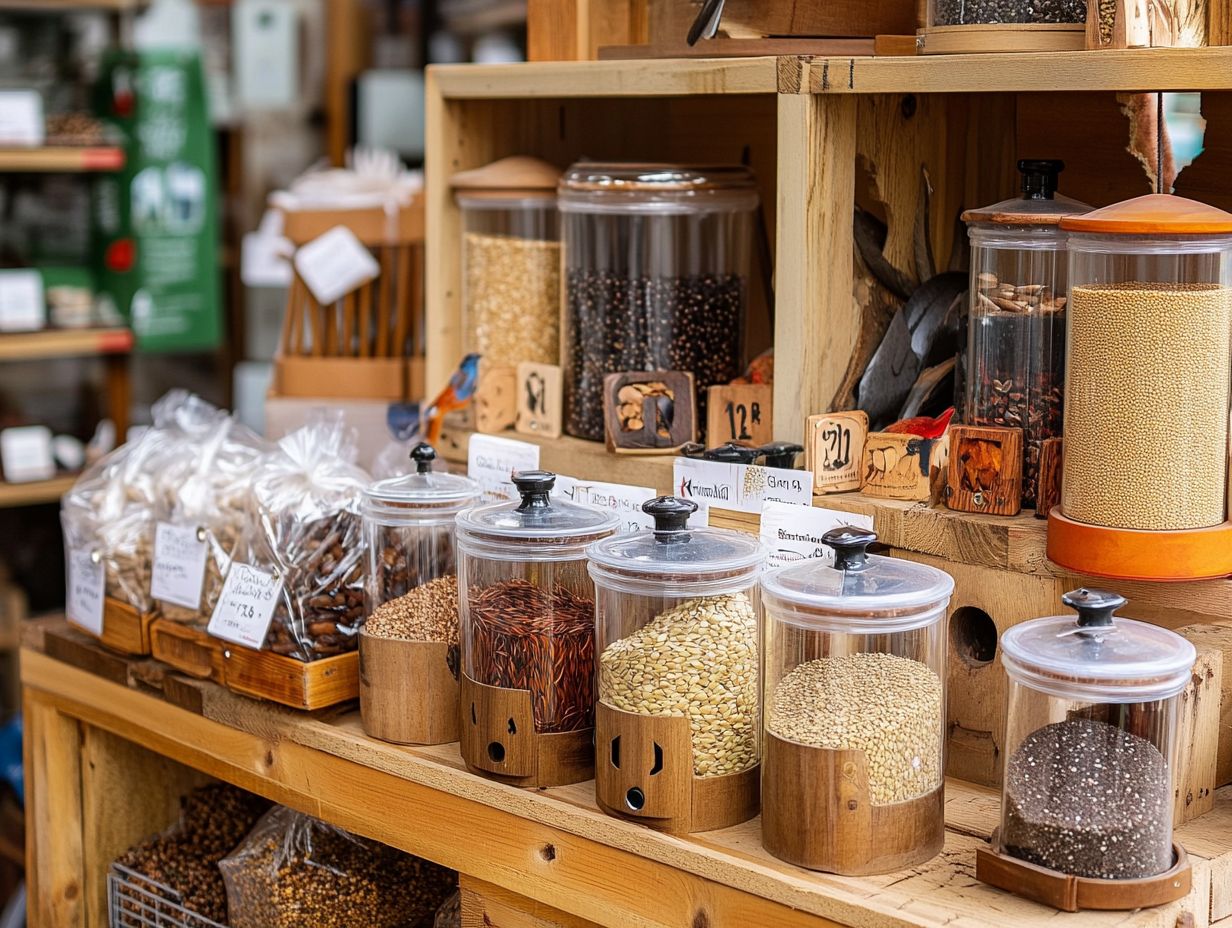
Understanding the bird species in your area is essential for choosing the right feeders and bird food that cater to their unique feeding habits and preferences.
By observing the types of birds that frequent your backyard, you can decipher their dietary needs and seasonal changes.
For instance, common visitors like finches and cardinals might favor sunflower seeds or thistle, while woodpeckers may be more inclined towards suet, a type of animal fat that many birds enjoy.
Taking note of these frequent visitors will help you create a feeding environment that draws in the right species.
Consider feeder placement to attract more birds, such as positioning them near shrubs for cover, which encourages a broader variety of birds to visit.
This mimics their natural behaviors and provides them with a sense of safety while they enjoy their meal.
Location and Mounting Options
The placement and mounting options of your bird feeder can greatly influence its effectiveness, the safety of the birds, and how easily you can monitor and maintain it.
Choosing the right location is essential; it ensures that birds feel secure while feeding and allows you to easily observe their activities.
Ideally, your feeders should be positioned near natural cover, such as bushes or trees, giving birds quick escape routes from potential predators.
Maintaining a clear view helps you enjoy watching your avian visitors without startling them.
With various mounting options available from pole mounts to window feeders you have the flexibility to place your feeder just right.
Elevated positions can enhance visibility and safety.
It’s crucial to assess the surroundings to strike a balance between accessibility for the birds and protection from common threats, like roaming cats.
Feeder Maintenance
Regular maintenance keeps your bird feeders clean and secure. This ensures the food stays fresh and free from mold.
Establish a cleaning routine every couple of weeks during peak feeding seasons. In colder months, use heated feeders to prevent food from freezing.
Inspect feeders regularly for wear and tear. Prompt replacements maintain a welcoming space for your feathered friends.
DIY Bird Feeders on a Budget
Building DIY bird feeders on a budget is fun and fulfilling! Attract your favorite birds without spending much.
Use simple ideas with everyday materials to create feeders for different bird species. Get creative while enjoying the process!
Simple and Cost-Effective Feeder Ideas
Make simple bird feeders with common household items. Attract a delightful variety of birds without overspending!
With a bit of creativity, repurpose plastic bottles, wood scraps, or tin cans. Each design serves as a practical feeding station and enhances your garden’s charm.
Find easy assembly instructions and tips to maximize the appeal of your feeders. Enjoy bird-watching right in your backyard!
Frequently Asked Questions
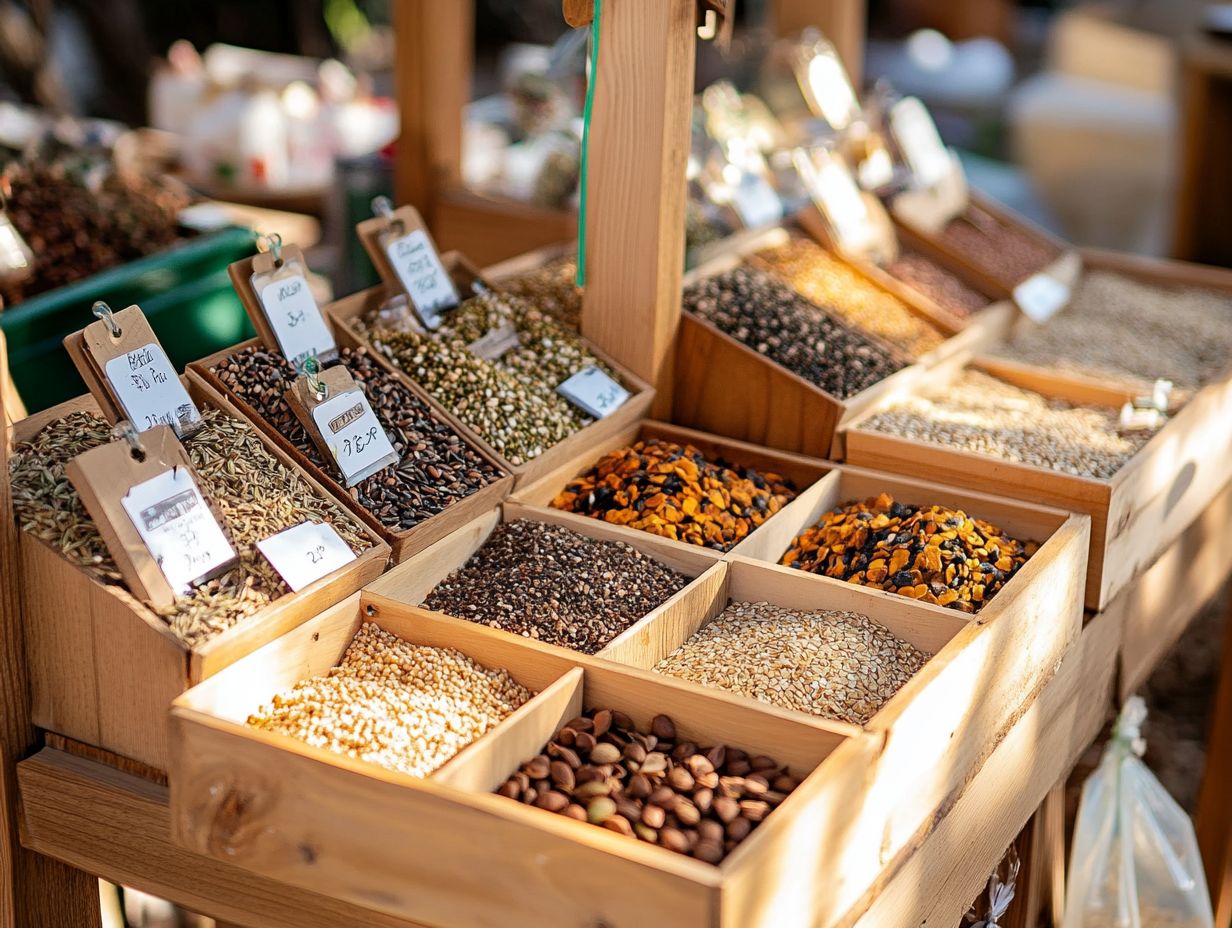
1. What should I consider when choosing a bird feeder for my budget?
Consider the size and type of birds you want to attract. Additionally, check out the 5 best bird feeders for your backyard to evaluate the feeder’s materials, durability, and maintenance costs.
2. How can I attract a variety of birds while staying within my budget?
Choose platform or tube feeders with multiple perches. They accommodate many bird species and are often affordable.
3. Are there any cost-effective DIY options for bird feeders?
Absolutely! Use recycled materials like plastic bottles or old wood. It’s a fun and eco-friendly way to attract birds!
4. Is it worth investing in a more expensive bird feeder?
That depends on your budget. While pricier feeders may offer more features, many affordable options still attract a wide range of birds, making it worthwhile to explore the ultimate guide to bird feeder types.
5. How often do I need to refill my bird feeder and how does it affect my budget?
Refilling frequency varies by feeder type and bird activity. Platform feeders may need refilling every 1-2 days, while hopper feeders can last a week.
6. Are there any low-maintenance bird feeder options for those on a budget?
Consider gravity-fed or self-dispensing feeders. They release food as needed, cutting down on frequent refills and saving you money!

